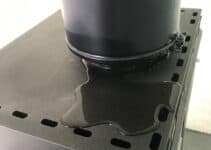When it comes to maintaining a wood burner, few tasks are as daunting yet necessary as removing an old flue pipe. I recently faced the need to extract one such pipe, an unsightly protrusion from the ceiling associated with an outdated wood burning stove. The journey from eyesore to clear space can be complex. With the right flue pipe removal guide, the procedure becomes less intimidating. My experience has provided me with insights that I’m eager to share, from identifying the essential tools to understanding the precise mechanics involved in how to remove flue pipe from wood burner systems.
Wood burner maintenance frequently requires a hands-on approach, and coming to grips with a firmly installed flue pipe might seem a Herculean task at first glance. Through my own endeavour, it became clear that employing force alone wouldn’t suffice. The anatomy of a wood burner’s flue often includes a twist-lock mechanism and various support structures, all of which are crucial to appreciate before undertaking removal. In this guide, I’ll walk you through the nuanced steps so that you can tackle the job with confidence.
Understanding Flue Pipe Mechanics and Safety Precautions
Delving into the process of wood burner flue pipe removal, I discovered that it requires more than just physical strength; a fundamental understanding of the mechanics involved is crucial. The intricacies of safely disassembling and removing a flue pipe from a wood burner call for an appreciation of the precision engineering that keeps these systems in place. In this section, we’ll explore the significant components that lie at the heart of this task and the essential safety measures that need to be observed.
Twist Locks and Their Significance in Flue Pipes
Twist locks play a vital role in the firm assembly of flue pipe systems in wood burners. It is necessary to understand how twist-lock mechanisms secure the sections of the pipe. Their design requires a deft rotation for both assembly and disassembly, foreclosing any movement that’s not aligned with their unlocking pattern. Removing flue pipe from a wood burner involves carefully rotating these locks without applying undue force, which could lead to damage.
Identifying Support Strapping and Fire Blocking Components
During my removal process, I encountered support elements such as strapping and fire blocking components. These are critical to the stability of the flue pipe installation, yet they present an additional challenge when dismantling. Identifying these parts is key, as they may require the use of specialized sawing tools for removal. They ensure the safety and compliance of the installation but necessitate a calculated approach to navigate effectively.
Necessary Safety Gear and Precautions Before Starting
Safety is of paramount importance when undertaking the removal of a wood burner flue pipe. It’s imperative to don the proper gear, including gloves and eye protection, before initiating the procedure. Such precautions are not merely recommended; they’re indispensable in guarding against possible injuries from sharp edges or falling debris. I found that being equipped with the correct safety attire also provided me with greater confidence as I engaged in the physical aspects of the task.
In conclusion, understanding the mechanics of flue pipe systems and adhering to safety precautions are essential steps for any homeowner or DIY enthusiast attempting a wood burner flue pipe removal. A methodical approach, informed by knowledge of the system’s components and a commitment to safety, is the surest path to accomplishing this task without injury or error.
Tools Required for the Flue Pipe Removal Process
Embarking on DIY flue pipe removal? The correct selection of tools can make a profound difference. My own experience has shown me the undeniable efficacy of having the right equipment at hand, ensuring the procedure is completed efficiently and safely. Whether you’re tackling a rigid or a more pliant pipe, there are specific instruments integral to the task.
Selecting the Right Metal Cutting Tools
Choosing effective metal cutting tools for flue pipe removal is essential. For firmer constructions, I favor an angle grinder paired with suitable discs, adept at cutting through metal with precision. This powerful tool is especially useful for severing any extending lips or fittings connected to the outer section of the pipe, facilitating a smooth severance.
The Role of Hammers and Reciprocating Saws in Detaching Flue Pipes
Adding to the arsenal, hammers and reciprocating saws stand as crucial for disassembling any firmly anchored sections. A reciprocating saw, in particular, is a versatile ally, able to navigate and cut through materials that might otherwise prove unyielding to simpler tools. The utilisation of both hammers and saws can substantially hasten the removal process.
Considerations When Purchasing or Renting DIY Equipment
When the time comes to procure your DIY removal kit, there are several considerations to ponder—such as the frequency of use, hiring versus buying, and potential deals that can impact your decisions. Personally, I advise weighing the advantages of investing in quality tools that can be used repeatedly against the convenience and cost-saving potential of renting. Assessing your specific situation and the scope of your project will guide you to the most advantageous choice.
How to Remove Flue Pipe from Wood Burner: Step-by-Step Guide
As someone who appreciates the value of maintaining a wood burner, I recognise the necessity of occasionally engaging in flue pipe maintenance. Removing a flue pipe is not as daunting as it may seem, provided you follow the correct steps to ensure a smooth and safe process. Here’s a detailed guide outlining the steps to remove a flue pipe from a wood burner, inclusive of detaching and discarding the recovered components.
- Begin at the highest point of your flue pipe setup. If accessible, start from the roof by detaching any screws that secure the outer chimney section.
- Next, carefully pry away any shingles or roofing materials to free the base of the chimney section from the roof. This is often necessary to prevent damage to the roof’s structure.
- For interior removals, identify and remove all nails or fastenings that anchor the chimney to the ceiling. Take your time with this step to preserve your ceiling’s integrity.
- Use a mallet to gently tap and dislodge the inner chimney from the structure. Patience is key here to avoid unnecessary force that could lead to damage.
- Once the inner chimney is free, focus shifts to detaching the flue pipe from the wood burner itself. This typically involves unscrewing any connecting parts at the flue collar.
Following these steps carefully will result in the wood burner flue pipe being ready for disposal. Ensure the proper lifting techniques or equipment such as a furniture dolly are employed to manage the weight and avoid personal injury. Finally, consult your local regulations for the appropriate disposal or recycling of the old flue pipe, upholding environmental responsibility.
- Climb onto the roof securely with the necessary safety gear to begin the exterior removal process.
- While working from the inside, clear the area around the wood burner to provide sufficient room for manoeuvering.
- Always use the appropriate tools for each step, which might include a screwdriver, mallet, or pry bar.
- If resistance is encountered, assess whether additional fastenings are hidden and need to be addressed.
- Lastly, have protective gloves and eyewear at all times to minimise the risk of injury from sharp edges or debris.
By adhering to these guidelines on how to remove a flue pipe, you can ensure a thorough and cautious flue pipe removal from your wood burner.
Addressing Potential Obstacles During Flue Pipe Removal
When I embarked on the task of wood stove flue pipe removal, the challenges that ensued were unexpected, yet surmountable. Through this experience, I’ve amassed a wealth of knowledge on overcoming flue pipe removal challenges that I believe will be invaluable to others facing similar predicaments.
One primary obstacle was contending with fire blocking—a safety feature within buildings designed to retard the spread of fire. Unfortunately, when it hinders flue pipe removal, a change in strategy becomes paramount. Similarly, support strapping can provide an additional obstacle, requiring a methodical approach and the use of robust cutting tools.
Limited access above the installation was another significant hurdle. In such a scenario, alternatives to the traditional top-down approach must be identified, often demanding ingenuity and patience. Nonetheless, by addressing these unforeseen obstacles methodically, the removal process is not only possible but can be executed with a degree of finesse.
Patience and persistence conquer all things. – Benjamin Franklin
Below is a table that outlines the specific challenges encountered during flue pipe removal and the corresponding strategies that I implemented to address them successfully:
| Challenge | Impact on Removal | Strategies Employed |
|---|---|---|
| Fire Blocking | Restrictions to vertical pipe movement | Use of metal cutting tools, careful dismantling to preserve structural integrity |
| Support Strapping | Additional anchoring of the flue pipe | Identification and removal with appropriate force and cutting instruments |
| Limited Access | Hindered pipe detachment | Employing alternative removal methods such as segment-by-segment disassembly |
In conclusion, meticulous preparation in the face of these challenges can significantly reduce the complexity of the wood stove flue pipe removal process. No obstacle is insurmountable with the right tools, techniques, and a resilient mindset.
Proper Disposal and Recycling of Old Flue Pipes
Once I’ve successfully extricated the flue pipe from its fixture, I’m immediately confronted with the enquiry of what to do with the discarded metal. In my pursuit of environmental responsibility in DIY, I ensure the next steps align with eco-friendly practices.
Environmental Considerations for Metal Waste
Disposing flue pipes in an environmentally conscious manner is a significant responsibility. The recognition that such waste possesses potential for recycling and reuse propels me towards sustainable disposal solutions. It’s paramount to acknowledge that every piece of metal slated for recycling conserves natural resources and energy, and thus contributes to a reduction in the overall environmental impact.
Finding Local Recycling Centres for Cast-Off Pipes
In my pursuit of finding a responsible end for the retired chimney flue pipe, I’ve compiled a detailed list of local recycling centres. These facilities are equipped to handle metal refuse and operate in compliance with the best recycling practices, assuring that the materials I contribute are repurposed with the least environmental footprint.
To aid those also in the midst of DIY projects, the table below provides a comparison of local recycling centres that accept chimney flue pipes:
| Recycling Centre | Accepted Materials | Processing Fees | Location |
|---|---|---|---|
| EcoCycle Services | All metals including chimney flue pipes | Free drop off | Birmingham |
| Green Alloy | Iron, Copper, Aluminium (including flue pipes) | Varies by weight | Sheffield |
| MetalWorks Recycling | Steel, Copper pipes, Flue components | Small fee for large quantities | Leeds |
| Urban Recycling | Metal flue pipes and fittings | Free for domestic amounts | Manchester |
While I find gratification in knowing my actions have a lesser toll on the environment, there’s also a sense of community contribution when recycling chimney flue pipe material. It’s gratifying to contribute to a circular economy, steering clear of unnecessary landfill and promoting environmental stewardship within the DIY realm.
Conclusion
In reviewing the methodical journey of flue pipe removal from wood burners, I’ve realised the significance of taking an educated and vigilant approach to disassemble the unit without damage or injury. The process necessitates a clear understanding of the flue pipe’s mechanics, ensuring the correct twist-lock mechanisms are navigated with care. Moreover, the successful deduction of this task has hinged on the procurement of appropriate tools, tailored to the tenacity of the materials in question.
Review of the Key Steps in Flue Pipe Removal
The key steps in the removal process demand attention to detail and precision, from correctly unlocking twist mechanisms to judiciously cutting through any support strapping that may be in place. My experience highlights the importance of anticipating challenges and acting resourcefully to overcome them. Reflecting on this task, it is apparent that a strategic, step-by-step approach is essential in navigating the complexities of removing a flue pipe. Furthermore, the exercise serves as a potent reminder of the virtues of adept project planning and execution.
Maintenance Tips to Prevent Future Flue Pipe Issues
Prevention, as they say, is better than cure. Regular maintenance of a wood burner extends beyond the simple cleaning of its surface; it entails a thorough check of the flue pipe’s integrity to prevent future issues. Adhering to a schedule for checks and cleaning can staunch the progression of wear and tear, maintaining the system’s efficiency and safety. Ensuring that the flue is unobstructed and in good repair not only enhances the overall performance of the wood burner but also fortifies the domestic domain against unintended hazards.



